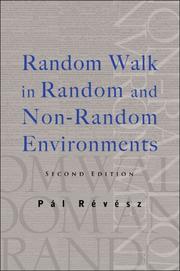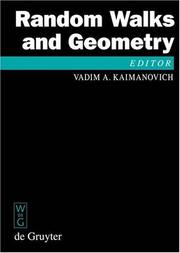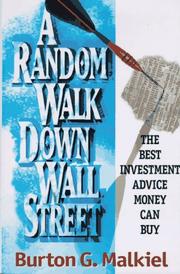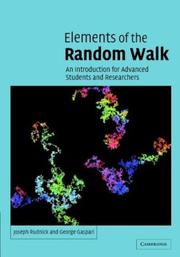| Listing 1 - 10 of 86 | << page >> |
Sort by
|
Book
ISBN: 129948624X 019155295X 0191775029 9780191552953 0199234868 9780199234868 Year: 2011 Publisher: Oxford OUP Oxford
Abstract | Keywords | Export | Availability | Bookmark
 Loading...
Loading...Choose an application
- Reference Manager
- EndNote
- RefWorks (Direct export to RefWorks)
"The name "random walk" for a problem of a displacement of a point in a sequence of independent random steps was coined by Karl Pearson in 1905 in a question posed to readers of "Nature". The same year, a similar problem was formulated by Albert Einstein in one of his Annus Mirabilis works. Even earlier such a problem was posed by Louis Bachelier in his thesis devoted to the theory of financial speculations in 1900. Nowadays the theory of random walks has proved useful in physics and chemistry (diffusion, reactions, mixing in flows), economics, biology (from animal spread to motion of subcellular structures) and in many other disciplines. The random walk approach serves not only as a model of simple diffusion but of many complex sub- and super-diffusive transport processes as well. This book discusses the main variants of random walks and gives the most important mathematical tools for their theoretical description"--

ISBN: 1281905763 9786611905767 9812703365 9789812703361 9789812563613 981256361X 981256361X 9781281905765 6611905766 Year: 2006 Publisher: New Jersey World scientific
Abstract | Keywords | Export | Availability | Bookmark
 Loading...
Loading...Choose an application
- Reference Manager
- EndNote
- RefWorks (Direct export to RefWorks)
The simplest mathematical model of the Brownian motion of physics is the simple, symmetric random walk. This book collects and compares current results - mostly strong theorems which describe the properties of a random walk. The modern problems of the limit theorems of probability theory are treated in the simple case of coin tossing. Taking advantage of this simplicity, the reader is familiarized with limit theorems (especially strong ones) without the burden of technical tools and difficulties. An easy way of considering the Wiener process is also given, through the study of the random walk.
Book
ISBN: 9810202377 9789810202378 9810237677 9789810237677 Year: 1990 Publisher: Singapore World Scientific
Abstract | Keywords | Export | Availability | Bookmark
 Loading...
Loading...Choose an application
- Reference Manager
- EndNote
- RefWorks (Direct export to RefWorks)


ISBN: 3110172372 9783110172379 9786612194337 128219433X 3110198088 9783110198089 Year: 2008 Publisher: Berlin Boston
Abstract | Keywords | Export | Availability | Bookmark
 Loading...
Loading...Choose an application
- Reference Manager
- EndNote
- RefWorks (Direct export to RefWorks)
Die jüngsten Entwicklungen zeigen, dass sich Wahrscheinlichkeitsverfahren zu einem sehr wirkungsvollen Werkzeug entwickelt haben, und das auf so unterschiedlichen Gebieten wie statistische Physik, dynamische Systeme, Riemann'sche Geometrie, Gruppentheorie, harmonische Analyse, Graphentheorie und Informatik. Recent developments show that probability methods have become a very powerful tool in such different areas as statistical physics, dynamical systems, Riemannian geometry, group theory, harmonic analysis, graph theory and computer science. This volume is an outcome of the special semester 2001 - Random Walks held at the Schrödinger Institute in Vienna, Austria. It contains original research articles with non-trivial new approaches based on applications of random walks and similar processes to Lie groups, geometric flows, physical models on infinite graphs, random number generators, Lyapunov exponents, geometric group theory, spectral theory of graphs and potential theory. Highlights are the first survey of the theory of the stochastic Loewner evolution and its applications to percolation theory (a new rapidly developing and very promising subject at the crossroads of probability, statistical physics and harmonic analysis), surveys on expander graphs, random matrices and quantum chaos, cellular automata and symbolic dynamical systems, and others. The contributors to the volume are the leading experts in the area. The book will provide a valuable source both for active researchers and graduate students in the respective fields.

ISBN: 0393038882 0393315290 9780393315295 Year: 1995 Publisher: New York : Norton,
Abstract | Keywords | Export | Availability | Bookmark
 Loading...
Loading...Choose an application
- Reference Manager
- EndNote
- RefWorks (Direct export to RefWorks)
Book
ISBN: 981444751X 9789814447515 9789814447508 9814447501 Year: 2013 Publisher: Singapore : World Scientific,
Abstract | Keywords | Export | Availability | Bookmark
 Loading...
Loading...Choose an application
- Reference Manager
- EndNote
- RefWorks (Direct export to RefWorks)
The simplest mathematical model of the Brownian motion of physics is the simple, symmetric random walk. This book collects and compares current results - mostly strong theorems which describe the properties of a random walk. The modern problems of the limit theorems of probability theory are treated in the simple case of coin tossing. Taking advantage of this simplicity, the reader is familiarized with limit theorems (especially strong ones) without the burden of technical tools and difficulties. An easy way of considering the Wiener process is also given, through the study of the random walk.
Book
ISBN: 3110479168 3110479451 9783110479454 9783110479454 9783110479164 3110479060 9783110479065 Year: 2016 Publisher: Berlin Boston
Abstract | Keywords | Export | Availability | Bookmark
 Loading...
Loading...Choose an application
- Reference Manager
- EndNote
- RefWorks (Direct export to RefWorks)
This monograph is devoted to random walk based stochastic algorithms for solving high-dimensional boundary value problems of mathematical physics and chemistry. It includes Monte Carlo methods where the random walks live not only on the boundary, but also inside the domain. A variety of examples from capacitance calculations to electron dynamics in semiconductors are discussed to illustrate the viability of the approach.The book is written for mathematicians who work in the field of partial differential and integral equations, physicists and engineers dealing with computational methods and applied probability, for students and postgraduates studying mathematical physics and numerical mathematics. Contents:IntroductionRandom walk algorithms for solving integral equationsRandom walk-on-boundary algorithms for the Laplace equationWalk-on-boundary algorithms for the heat equationSpatial problems of elasticityVariants of the random walk on boundary for solving stationary potential problemsSplitting and survival probabilities in random walk methods and applicationsA random WOS-based KMC method for electron-hole recombinationsMonte Carlo methods for computing macromolecules properties and solving related problemsBibliography
Boundary value problems --- Stochastic analysis. --- Random walks (Mathematics) --- Additive process (Probability theory) --- Random walk process (Mathematics) --- Walks, Random (Mathematics) --- Stochastic processes --- Analysis, Stochastic --- Mathematical analysis --- Numerical solutions.

ISBN: 9780511610912 9780521828918 9780521535830 9780511648137 0511648138 0511610912 0511187505 9780511187506 0511186576 9780511186578 0521828910 1107147670 9781107147676 1282394770 9781282394773 9786612394775 6612394773 0511644353 9780511644351 0511566492 9780511566493 0521535832 Year: 2004 Publisher: Cambridge New York Cambridge University Press
Abstract | Keywords | Export | Availability | Bookmark
 Loading...
Loading...Choose an application
- Reference Manager
- EndNote
- RefWorks (Direct export to RefWorks)
Random walks have proven to be a useful model in understanding processes across a wide spectrum of scientific disciplines. Elements of the Random Walk is an introduction to some of the most powerful and general techniques used in the application of these ideas. The mathematical construct that runs through the analysis of the topics covered in this book, unifying the mathematical treatment, is the generating function. Although the reader is introduced to analytical tools, such as path-integrals and field-theoretical formalism, the book is self-contained in that basic concepts are developed and relevant fundamental findings fully discussed. Mathematical background is provided in supplements at the end of each chapter, when appropriate. This text will appeal to graduate students across science, engineering and mathematics who need to understand the applications of random walk techniques, as well as to established researchers.
Book
ISBN: 9780511750854 9780521519182 9780511750113 0511750110 9780511743566 0511743564 9780511744655 051174465X 0511750854 0521519187 9780511742491 0511742495 1107207126 1282631675 9786612631672 0511749368 Year: 2010 Publisher: Cambridge New York Cambridge University Press
Abstract | Keywords | Export | Availability | Bookmark
 Loading...
Loading...Choose an application
- Reference Manager
- EndNote
- RefWorks (Direct export to RefWorks)
Random walks are stochastic processes formed by successive summation of independent, identically distributed random variables and are one of the most studied topics in probability theory. This contemporary introduction evolved from courses taught at Cornell University and the University of Chicago by the first author, who is one of the most highly regarded researchers in the field of stochastic processes. This text meets the need for a modern reference to the detailed properties of an important class of random walks on the integer lattice. It is suitable for probabilists, mathematicians working in related fields, and for researchers in other disciplines who use random walks in modeling.
Book
ISBN: 1316867900 1316868087 1139208462 1316868265 1316868443 1316868982 1316866823 9781316868980 9781139208468 9781107026698 1107026695 Year: 2017 Publisher: Cambridge
Abstract | Keywords | Export | Availability | Bookmark
 Loading...
Loading...Choose an application
- Reference Manager
- EndNote
- RefWorks (Direct export to RefWorks)
Stochastic systems provide powerful abstract models for a variety of important real-life applications: for example, power supply, traffic flow, data transmission. They (and the real systems they model) are often subject to phase transitions, behaving in one way when a parameter is below a certain critical value, then switching behaviour as soon as that critical value is reached. In a real system, we do not necessarily have control over all the parameter values, so it is important to know how to find critical points and to understand system behaviour near these points. This book is a modern presentation of the 'semimartingale' or 'Lyapunov function' method applied to near-critical stochastic systems, exemplified by non-homogeneous random walks. Applications treat near-critical stochastic systems and range across modern probability theory from stochastic billiards models to interacting particle systems. Spatially non-homogeneous random walks are explored in depth, as they provide prototypical near-critical systems.
| Listing 1 - 10 of 86 | << page >> |
Sort by
|

 Search
Search Feedback
Feedback About UniCat
About UniCat  Help
Help News
News